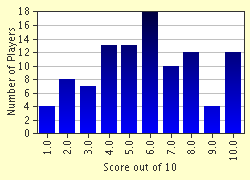Quiz Answer Key and Fun Facts
1. Which country was the first to experience a revolution in 1848?
2. The February Revolution of 1848 swept away the monarchy in which country?
3. The 1848 revolution in Austria led to which politician's fall from power?
4. Despite the name, in which country did the Greater Poland Uprising take place in 1848, sparking further revolts in that country, particularly the capital?
5. Which pope was confronted with a revolution in the Papal States?
6. Lajos Kossuth was the leader of which ethnic grouping within the Austrian Empire as they struggled for independence in 1848.
7. Which nation came to the aid of Austria in putting down the revolutions in its lands?
8. In March 1848 King Oskar I authorised his troops to fire on protestors demanding a republic. Of which country was Oskar king?
9. The United Kingdom did not really undergo a revolution as such in 1848 but there were demands for political reform from which group?
10. One of the last of the Revolutions of 1848 actually took place in 1849: the May Uprising in Dresden. Of which German state was Dresden the capital?
Source: Author
alan03
This quiz was reviewed by FunTrivia editor
bloomsby before going online.
Any errors found in FunTrivia content are routinely corrected through our feedback system.

